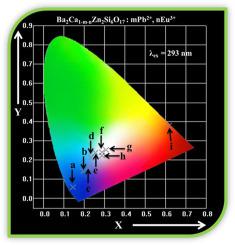Solid State Sciences ( IF 3.4 ) Pub Date : 2021-06-04 , DOI: 10.1016/j.solidstatesciences.2021.106665 P. Balakrishnan , S. Masilla Moses Kennedy

|
In this work, the non-rare earth element Pb2+ ions doped, and co-doped with the rare earth element Eu3+ ions in the silicate based Ba2CaZn2Si6O17 phosphors were prepared by using the simple solid state reaction process. To know about the phase formation, and the surface morphology of the as prepared powder samples, the powder X-ray diffraction (PXRD), and the scanning electron microscope (SEM) techniques were employed respectively. To measure the luminescence properties of the phosphors, the photoluminescence excitation (PLE), and the photoluminescence (PL) emission were recorded. Under the 293 nm excitation, the co-doped phosphors (hereafter referred to as phosphors/samples) exhibit ‘a broad blue emission band at 438 nm’, and ‘five sharp bands at 579, 593, 611, 653, and 704 nm’, corresponding to the characteristic transitions of the Pb2+ and the Eu3+ ions in the same order. The energy transfer efficiency in the phosphors, between the sensitizer Pb2+, and the activator Eu3+ ions, was investigated. The effect of the concentration quenching is used to calculate the critical distance Rc in the sample was obtained to be 16.74 Å. The PL decay time showed a decreasing trend when the concentration of the Eu3+ activator ions was increasing. The PL emission spectra of the samples were used to measure the CIE chromaticity color coordinates, and the correlated color temperature (CCT). The quantum efficiency values of the samples were also measured. Finally, to know about the PL thermal stability of the phosphor, the temperature dependent photoluminescence (TDPL) was performed, and the activation energy was calculated as 0.167 eV. From the above results, the Ba2CaZn2Si6O17:Pb2+, Eu3+ phosphors can be the promising color tunable phosphors in the white light emitting diode (WLED) applications.
中文翻译:

来自单相 Ba 2 CaZn 2 Si 6 O 17 :Pb 2+、Eu 3+硅酸盐磷光体的可调光发射,通过能量转移效率用于白光发光二极管应用
在这项工作中,在硅酸盐基Ba 2 CaZn 2 Si 6 O 17 中掺杂非稀土元素Pb 2+离子,并与稀土元素Eu 3+离子共掺杂荧光粉是通过使用简单的固态反应过程制备的。为了了解所制备粉末样品的相形成和表面形貌,分别采用粉末 X 射线衍射 (PXRD) 和扫描电子显微镜 (SEM) 技术。为了测量磷光体的发光特性,记录了光致发光激发 (PLE) 和光致发光 (PL) 发射。在 293 nm 激发下,共掺杂磷光体(以下称为磷光体/样品)表现出“438 nm 处的宽蓝色发射带”和“579、593、611、653 和 704 nm 处的五个锐带” ,对应于 Pb 2+和 Eu 3+的特征跃迁离子顺序相同。研究了磷光体中敏化剂 Pb 2+和活化剂 Eu 3+离子之间的能量转移效率。浓度猝灭效应用于计算样品中的临界距离 R c为 16.74 Å。当 Eu 3+浓度增加时,PL 衰减时间呈下降趋势活化剂离子增加。样品的 PL 发射光谱用于测量 CIE 色度色坐标和相关色温 (CCT)。还测量了样品的量子效率值。最后,为了了解荧光粉的 PL 热稳定性,进行了温度相关光致发光 (TDPL),计算出的活化能为 0.167 eV。从以上结果可以看出,Ba 2 CaZn 2 Si 6 O 17 :Pb 2+、Eu 3+荧光粉是白光发光二极管(WLED)应用中很有前景的颜色可调荧光粉。











































 京公网安备 11010802027423号
京公网安备 11010802027423号